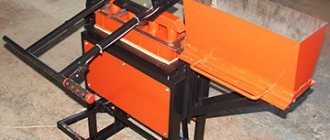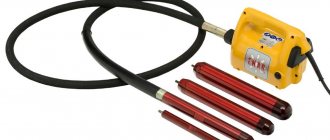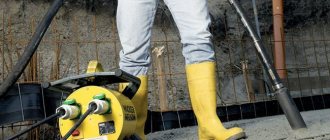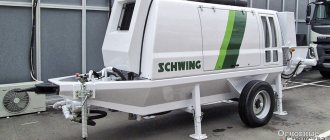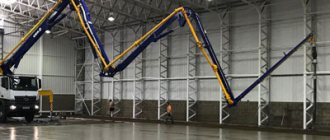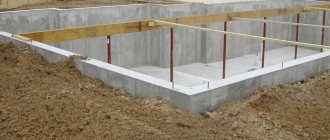A concrete pump is a special design that is designed to continuously supply concrete during construction. The design is simple and can bring a lot of benefits:
- bunker - a reservoir where the solution ready for transportation arrives;
- a pump that continuously supplies concrete.
These are the basic elements. In addition to them, there are several types of hoses, but they are included in the “consumables” category and will be discussed later.
There are several indicators of the need to use a concrete pump:
- Large construction projects. Most often, the object is used in the construction of railway bridge overpasses, as well as other large-sized buildings;
- If it is impossible to supply the solution in any other way.
On average, a concrete pump is capable of pumping solution to a height of 60 m at a distance of up to 300 meters. Moreover, thanks to the use of special production means, the properties of the mixture are not lost during transportation.
Purpose, principle of operation of the concrete pump
The concrete mixture passing through the pump has a proven composition. The size of the components is selected taking into account the characteristics of the pumping unit. For better sliding, a plasticizer is added to the batch. The mixture is supplied through pipes with a diameter of 6-12 cm, so the fractional composition does not exceed 2-4 cm in cross-section. For easy pumping, the grain size should be 3 times smaller than the cross-section of the concrete pipeline.
The concrete blower includes:
- mounting frame for securing equipment:
- feed hopper with continuous agitator
- main engine;
- mass injection unit to the sampling point;
- concrete drainage device - sleeve, elbow, lock with rubber seal, washing line.
The system is complex, with hydraulics, control valves, and control devices. Various types of pumps are used.
Stations can be stationary, on a trailed wheeled chassis, concrete pumps and pneumatic blowers. The stationary concrete pump is part of the concrete concrete production line for the production of cast straight and shaped products.
A mobile concrete pump installed directly on a construction site is used for pouring:
- slab foundations;
- monolithic walls;
- bridges and dams;
- supply of mortar or concrete for pouring interfloor ceilings during monumental construction.
The construction mixture with RBU is delivered by mixers and unloaded into the hopper of a concrete pump on a wheeled chassis.
Pneumatic supercharger - supply of a mixture ready or mixed in a hopper along an overpass under compressor pressure. Suitable for pumping semi-dry mixtures.
There is no suction line in a concrete pump, only discharge. A similar principle of operation is typical for piston, rotary or screw mechanisms.
Piston systems
Initially, concrete pumps were built as single-cylinder piston units driven by a crank mechanism. A piston moving along the sleeve captured and pushed a portion of the cement pulp into the pipe. At the same time, the flow at the outlet pulsated, making it difficult to hold the concrete pipe. The first Putzmeister installations had cylinder lengths of up to 3 meters, an internal chamber diameter of 23 cm, and a capacity of up to 125 m3/hour.
A modern piston concrete pump is a complex system with electronic process control. Two or more pistons work in counter mode, reducing the pulsation of the mass at the outlet of the pipe. The pistons move due to a hydraulic drive from an electric motor or diesel engine. The concrete supply process is regulated by gates installed on the injection line and the outlet from the bunker.
Operating principle of the piston system:
- The hopper with the mixing device is connected to the piston cylinder. A cutting gate is installed between them.
- The piston moves away from the hopper (reverse stroke), there is a vacuum in the sleeve. The gate opens, the void is filled, and the mass is captured .
- The piston is at the greatest distance - the hopper gate closes, the valve on the discharge pipe opens.
- With a straight stroke, the piston pushes the mass into the pipe.
The second piston works in antiphase, reducing the pulsation of the concrete pipe.
The concrete mass should not delaminate or remain in the bunker for a long time - the strength of the concrete will decrease. Therefore, a stirrer operates in the hopper. The mixture is delivered based on consumption. If workers manage to lay 5 cubic meters in an hour, then that’s how much concrete should go into the bunker.
A modern piston concrete pump is often called hydraulic in the technical literature. In the pump, the drive, feed and switch cylinders are hydraulically operated. The oil in the system is regulated by a distributor. The system is controlled electronically.
The advantages of a piston concrete pump include supplying mass with high pressure, servicing the construction of high-rise buildings and supplying over long distances. The high productivity of the installations ensures their demand.
The disadvantages of the system include:
- complexity of equipment;
- presence of an additional pressure pump;
- intense abrasive wear of the gate seat;
- uneven supply of solution, leading to pipe pulsation.
Despite the shortcomings, 75% of concrete pumps in the world use the piston system.
Pistonless rotor systems
Rotary and screw installations are mechanical. They do not have gates; the concrete pump is driven by an electric motor. The equipment is designed for different productivity. The screw pump works like a meat grinder, taking the solution from the hopper and directing it into the concrete pipeline. The unit is characterized by low consumption, pumping a semi-dry mixture without plugs, with possible reverse movement.
A rotary concrete pump is much simpler than a piston pump. The equipment is less noisy, the solution supply is uniform, without pulsation. Development of the rotary engine was completed in 1957.
Installation includes:
- Mounting frame or chassis.
- Actuator.
- Loading hopper with mixer or receiving sleeve from the mixer.
- Rotary pressure chamber.
- Concrete plant.
Rotor in translation means a triangular shaft. Rubberized, pushing rollers are attached to it. They dynamically compress a reinforced rubber hose with a cross-section of 125 mm with a concrete mass. The pipe passes through the pump housing. The rotor rolls along the sleeve using a pair: a gear wheel - a fixed gear. The mixture in the hose moves due to its extrusion by crimping.
The rotary concrete mixer is used as a mobile one, with delivery to the construction site. This type of equipment is equipped with concrete pumps. The cost of the units is significantly lower than piston units.
The disadvantages of the equipment are:
- Rapid wear of part of the botton pipeline located inside the chamber. The insert is a consumable item; a quick replacement algorithm has been developed.
- Does not work on mass with inert inclusions larger than 10 mm in cross-section.
- During continuous operation it overheats, operation stops for 3-4 hours.
The system is simple, compact, of low productivity, but with the ability to pump heavy, thick construction mixture. The pump smoothly delivers the contents of the hopper under low pressure. In some cases, this is important for the integrity of the formwork or for small cells of the reinforcing mesh. The installation capacity is 60-80 m3 per shift.
Peculiarities
Diagram of a single-acting piston tool.
To start work, a special cement laitance or a special chemical starting mixture is used. Cement laitance can be made directly on the construction site itself using several bags of cement and water.
The pipes can be extended to the desired length, which significantly exceeds the boom reach. At the end of the pipeline there is a special rubber sleeve, which is often called a trunk. This device makes it possible to maneuver during the concreting process. The main pipeline is used to supply concrete directly to the foundation, to the basements of the house, precisely where it is completely impossible to use a boom due to the presence of certain power lines at the site.
Trailed tool diagram: 1 – Chassis, 2 – Cylinder block, 3 – Receiving hopper, 4 – Drive, 5 – Casing.
Tools vary in type, they can be mechanical and hydraulic, and in terms of pump design they can be piston or pistonless, stationary or car-based.
Thanks to this, the resistance to moving the mixture in the concrete pipeline is greatly reduced, which makes it possible to use an engine of much lower power than in the structure itself with a mechanical or connecting rod drive. Hydraulic is capable of moving a concrete mixture to a very large height and distance. Compared to similar mechanical drives, hydraulic ones create unusually high pressure in the concrete pipeline.
A concrete pump with a piston drive is subject to wear of the pistons due to constant friction, which is caused by special microparticles of the concrete mixture and cement laitance, penetrating directly between the walls of the pistons and the piston cylinder itself. Wear with a mechanical drive occurs much faster than with similar hydraulic ones, because they have a much smaller piston stroke reserve, and forces them to perform a much larger number of cycles to achieve the required pressure in the concrete pipeline.
Pershnev with two cylinders is capable of supplying concrete almost constantly and continuously, which is ensured by alternating cycles of pumping the concrete itself into the cylinders. A concrete pump with one cylinder operates with some interruptions, because the concrete mixture it supplies in the concrete pipeline pulsates from maximum to minimum pressure, just as the piston itself moves.
In hydraulic piston engines, the special filler is water or mineral oil, which has quite strong pressure and ensures rapid pumping of concrete.
Rotary, which is classified as pistonless, is designed in such a way that inside it there is a special housing, inside of which there is a rotor with special pushing and pressure rollers attached to it, which are covered with rubber along the entire perimeter. There is a special rubber-lined hole in the rotor housing, in which a special reinforced rubber hose is directly located.
When the rotor rotates in a certain direction, special rubber-coated rollers press the hose, while moving the concrete mixture directly along the hose, starting from the receiving hopper and ending with the concrete pipe. The design of the rotary ensures a fairly uniform supply of concrete, including harder ones, because blockages in them are eliminated very quickly by switching the pump to the reverse function. However, the performance of rotary ones is quite small.
These are used for fairly small volumes of work, namely in those areas where the supply and placement of concrete is significantly complicated by too much reinforcement. The main disadvantage of absolutely any performance is the too rapid wear of the hose, which is damaged by the aggregate of the concrete mixture, in particular such as crushed stone.
Types of concrete pumps and features of their operation:
Classification of concrete pumps by mobility
A concrete pump is a system designed to move a solution under pressure to the place of application. The nature of the production dictates what type of concrete pumping stations to use.
At the concrete concrete plant, the installation is built into the production line and is stationary. It is delivered to the construction site by transport and left for the duration of the work. For one-time pouring of large volumes, a concrete pump is used. If you need a small volume of solution, you can order a mini-installation or rent special equipment.
Automotive equipment
Unlimited mobility of the concrete supply unit is possible if the equipment is mounted on a truck chassis. In such installations, the main thing is reliability and ease of maintenance. Preference is given to rotary concrete pumps. There are no air pockets in them.
A distribution boom in the form of a sectional folding pipe with a total length of 10-100 meters with a flexible hose-trunk allows you to deliver the product to the desired distance and height. Linear concrete pumps (ABN) are equipped with flexible hoses that create a telescopic pipe.
The truck-mounted concrete pump can operate in remote areas, move to any area of the construction site, subject to the requirements of SNiP 12-04-2002, 12-03-2001 for the safe operation of hydraulic pumping equipment and compliance with safety regulations.
The use of ABN is justified when the volume of work is small and the objects are located on a remote site. Mobile concrete pumps serve facilities not connected to power grids. The equipment is used for laying concrete on roads, during the construction of bridges and overpasses. The equipment is used in pouring slab foundations and supplying concrete for the construction of low-rise buildings.
Advantages of ABS:
- the ability to supply construction mixture to a height of 70 or a distance of 200 meters;
- maneuverability and compactness of the station;
- installation productivity up to 90 m3/hour;
- the ability to supply the mixture to different horizons, as far as the boom reach allows;
- energy independence.
Flaws:
- high cost of equipment or its rental;
- Obstacles in the area of boom movement interfere and create danger.
- free space is required to turn or maneuver.
A little more than half a century has passed since the creation of the first concrete pump on a car chassis. Today, equipment is presented by domestic and foreign manufacturers in a wide range.
Automotive concrete pumps are selected based on a comparison of the characteristics presented in the passport:
- The determining indicator is the type of pump, flow rate and pressure on the discharge line.
- Engine volume and fuel consumption.
- Chassis load capacity.
- Arrow size.
In Russia, 95% of ABNs on a wheeled chassis are represented by foreign manufacturers. The Tuymazinsky concrete truck plant installs units produced by the German company Liebherr on KamAZ chassis, creating the TZA-Liebherr model. The installation price is cheaper, the demand is higher. In Naberezhnye Chelny, (Russian-Turkish production) it assembles concrete pumps using a Mercedes chassis, a Korean JUNLIN superstructure with a Rexroht hydromatik hydraulic pump. 5 models have been developed in the middle price category, designed for different performance.
Concrete pumps on wheeled chassis KCP, Kyunwon, Dongyang from South Korean companies are sold at a reasonable price. Chinese manufacturers, having absorbed German companies, supply their products under the brands Zoomloin and Sany. Italian wheeled concrete pumps from CIFA and Mecbo are in demand.
Stationary concrete pumps
Equipment for pumping concrete to the pouring site is divided into mobile and stationary. If the equipment is assembled on a wheeled or tracked chassis and moves to the work site under its own power, the installation is mobile.
Most concrete pumps are mounted on a frame or trailer. The units are delivered by tractors to the place of application or are included in the concrete concrete production line. They are installed in an area convenient for access by the mixer and maintenance of concrete pipes.
If the construction site is connected to energy resources, there is a source of water supply, a stationary concrete pump is more profitable than a mobile one. The assembly uses a powerful piston station, which allows it to serve construction with a high consumption of concrete mixture. The concrete pump delivers the solution over a distance of up to 300 and a height of up to 100 meters.
The advantages of the station outweigh the inconveniences associated with the lack of mobility and the risk of accidentally damaging the laid hoses.
The station is assembled compactly, the pump is placed next to the boom base and the receiving hopper. The boom in the form of a metal pipe on a hinged stand rotates horizontally. A concrete pipeline 4-8 m long with a rubber tip is attached to it. The pipes can be extended, but the rubber tip must complete the structure. The hose under pressure cannot be held and directed, so it is attached to the support with special clamps.
Requirements to ensure uninterrupted operation of the concrete pump:
- Before starting the unit, the hopper must be charged with a special starting mixture, which coats all surfaces for better gliding.
- A level area for placing supports, a source of water and a place to drain the waste are required.
- The unloading location may be above or below the pouring area.
- It is important that there are no air bubbles in the concrete when pouring. Deep vibrators are used or layer-by-layer filling is performed.
- Until the mass from the hopper is exhausted, the pump must operate without interruption so that plugs do not form inside the system.
- Concrete is supplied under pressure; additional reinforcement of the reinforcing mesh is required.
A flexible pipe allows you to supply the solution from top to bottom and bottom to top. You can lay a concrete pipeline on the ground, lift it with a crane to a height, or fill the lower pit along a ladder. Pulling flexible pipe is faster than installing a conveyor belt to the service point.
How to make a simple concrete pump
To assemble a concrete pump with your own hands, you need to stock up on materials and tools that are indicated in the drawings. What you need: a steel pipe for the cylinder, a sheet of metal 5 millimeters thick, a lathe, round metal sheets (to make the piston and valve), a screwdriver, an electric motor, wrenches and bolts, a welded frame, a gearbox with a reduction gear, plastic or steel pipes for concrete pipeline.
Usually, for self-assembly, mechanisms with one piston are chosen.
The main stages of producing a mini-concrete pump with your own hands:
- Searching for a drawing, drawing up a plan indicating everything necessary, a design diagram.
- You need to select a cylinder and a piston - these are the key parts. The cylinder diameter should be a maximum of 400 millimeters (but smaller is better), the piston stroke should be at least 0.5 meters. If the parameters do not match, the mechanism will quickly wear out. Parts must be precisely made, without roughness.
- Pump selection - it can be hydraulic or electromechanical.
- Gearbox - must include a gear ratio to reduce and convert rotational movements into translational ones.
- King pin – connected to the mechanism.
- A metal corner is used as a welded frame.
- Making check valves from steel.
All parts are checked and assembled into a single mechanism using a drawing (it is desirable that there is also a drive diagram of all structural components). Next, you need to check your work. You cannot start the unit without concrete inside or a special starting mixture. It is prepared independently from an ordinary concrete mixture diluted in water, and then machine oil is added.
Special concrete pumps
Concrete pumps on a wheeled chassis, complete with mixers, represent a hybrid technique designed for transporting and pouring concrete into prepared formwork. This technique is more difficult to operate and more expensive, but it reduces labor costs by half and speeds up pouring. But it can be used to supply solution no higher than 30 meters.
Truck-mikser-pulp complexes are a type of ABN. The combination of a powerful concrete pump and mixer allows you to supply the pulp to a height of up to 100 meters. An example of such equipment is the Cifa mobile ABN systems of the Carbotech series. The last links of the prefabricated pipe are made of carbon fiber. This simplifies the design and increases the reliability of the boom. Another direction of the same manufacturer is strengthening the boom using double-walled steel pipes in units of the Long Life Pipes series.
Mobile hybrid installations are used when construction is carried out at a distance from the RBU. A long transport arm shortens the time allotted for laying the mortar. The operating principle of hybrid technology is that the concrete mass is continuously mixed, preventing the concrete from thickening. The stirrer blades push the solution towards the valve, and the piston pushes it through the valve on the discharge line.
Favorable conditions for using special equipment:
- The ordered amount of mortar is delivered in one trip for low-rise construction.
- Concreting of overpasses and tunnels, bridges, road construction.
- When laying mortar is not accessible at a height from inside the room, there is no scaffolding outside.
- There are several receiving points at the construction site, prepared for dosed concrete placement.
When choosing the type of concrete mixture transportation, you should take into account that the cost of operating hybrid equipment is higher than ABS.
Another type of special equipment is a concrete pump mounted on crawler tracks. Puddles, viscous soil and marshy areas will not become an obstacle to movement. Therefore, for drilling equipment, off-road and on mountain slopes, there is no alternative to equipment located on a tracked platform.
Another type of concrete pumps are stationary installations designed for spraying concrete onto walls. One unit in the mixer prepares the solution, pumps it into the pipe and sprays it in the boom using an air stream from the compressor.
Flaws
Concrete pumps have certain disadvantages that need to be taken into account when purchasing.
This technology is expensive and is not available to all users and companies.
But, with its regular use in construction, it justifies itself. When operating the equipment, it is necessary to install a concrete pipeline. A pipe system on the boom solves the problem.
If there is a need for spot filling of small areas, for example, when installing a prefabricated monolithic structure, this equipment is not advisable to use. During long-term operation of the installations, wear of the pump mechanism and pipe is observed.
Mobile mini-stations
The technology used for laying concrete is complex and expensive. To justify the purchase and make a profit, it must operate at maximum capacity. On large construction sites, heavy-duty, productive ABS pays off. In low-rise construction, it is better to use the mini type of equipment.
When choosing equipment, pay attention to the technical capabilities of small-sized installations. Self-propelled units have high maneuverability, which is important for narrow streets in old buildings.
If the ABN on the KamAZ platform requires a turning area of 10-12 m2, for small-sized equipment you need 2 times less. Considering that the height of the structure does not exceed 6 meters, mini-equipment can be installed indoors in a closed production area.
The equipment is multifunctional; it can work on ready-made concrete poured into a bunker or prepare a building mixture from dry components in it, if a mixer is included in the kit.
To service the ABN, 5-6 auxiliary workers are required; the mini station is served by a driver and a worker.
Technical characteristics of mini concrete pumps:
- Types of pumps – rotary and piston.
- Stationary and mobile pulp pumping stations.
- Engine: diesel or electric.
- The maximum horizontal pumping distance is 150 meters.
- The maximum injection height is 50 meters.
- capacity options 5-62 m3/hour.
- High maneuverability.
Often the capabilities of such equipment are sufficient for the construction of low-rise buildings. There is a peculiarity - all pumping processes must be completed within 20 minutes, after which the labyrinths must be washed under pressure.
The average weight of a stationary unit is about a ton; it can be delivered to the site by light-duty transport. The cost of renting or purchasing a mini-concrete pump pays off within 6-8 months, provided it is fully loaded. When choosing equipment, you need to remember that a piston pump is 2 times more productive than a rotary pump. However, the rotary one operates with low noise and pumps the thick mass evenly without pulsation.
Starting mixture for concrete pumps
Builders know that even when moving, concrete begins to settle on the walls and harden. To prevent this from happening in the labyrinths of the unit, an immutable rule is that starting up the equipment begins with pumping the starting mixture as a lubricant.
The mixture is liquid, resembles milk, and is prepared from organic polymer compounds and mineral salts. The composition is environmentally friendly, increases the sliding of concrete along the walls, and reduces abrasive wear. In Russia, in practice they use cement laitance - a dry mixture supplied from a cement plant in bags or homemade, made on site.
An aqueous solution in the calculated amount is poured into the hopper, mixed and the pump is turned on, lubricating the entire pipeline with liquid. Experts believe that special compositions, unlike homemade ones, do not affect the quality and consistency of ready-mixed concrete. Their use extends the service life of gates and other surfaces in contact with concrete.
Recommendations for choosing concrete pumps
First of all, you need to decide whether the equipment will be purchased or rented. You have a large construction company, concreting work - the main technological process - stationary concrete pumps on a wheeled trailer - the best equipment. Low-rise, scattered construction sites - ABN can help you.
For the construction of individual objects, where it is impossible to ensure a constant load on the equipment, it is profitable to rent a concrete pump.
Specialized stores sell new and used equipment from different manufacturers. It is important for you to choose a concrete pump according to your request. ABS is more expensive - the equipment is non-removable and installed on the chassis of a truck.
Important selection criteria:
- type of concrete pump - piston or rotary;
- power of the power plant or engine;
- pressure and distance of pumping concrete mixture;
- solution productivity;
- pipe pressure;
- manufacturer.
Check what permissible granule size the manufacturer has included in the technical characteristics, climatic and other operating features of the equipment.
It is more profitable to rent equipment. If the unit does not fit, it can be replaced. Maintenance, management and troubleshooting are usually the responsibility of the landlord.
Stationary
Scheme of a stationary concrete pump.
The most common stationary one is made in several different versions and is installed mainly on a flatbed truck or a special platform that provides ease of transportation. It should be noted that this design is made in the form of a trailer with a chassis and works to ensure a continuous supply of concrete. This one can be transported from one construction site to another by simply hooking it onto a special attachment to the truck. The operating principle is based on the fact that this unit can continuously pump large quantities of concrete. The design of such a device supports two different modes at once, such as supplying concrete under fairly high pressure, however, with this operating mode, productivity drops very much, and a very low pressure mode, but with much higher productivity. This need is due to the fact that when laying concrete pipes at sharp corners, it is necessary to develop very high pressure in the cylinders themselves, thereby slightly raising the concrete itself underneath them.

